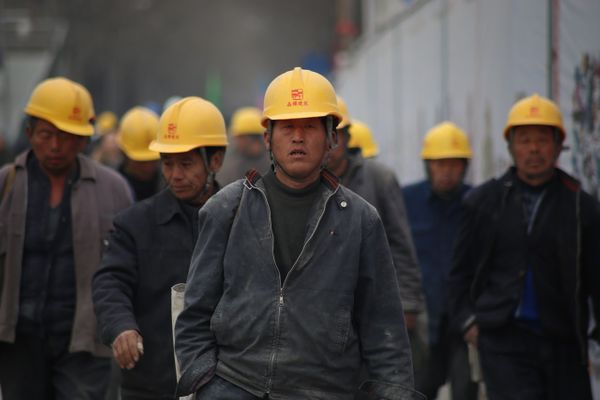6.3.2
Technology & Control
Technology and Control of the Labour Process
Technology and Control of the Labour Process
Scientific management was first proposed by Taylor who believed that the best way to increase production was to make the labour process independent of the autonomy, creativity and ability of the individual worker.


Scientific management
Scientific management
- Taylor was interested in how management could increase its control over the workforce, reduce the power of workers over the labour process and ensure maximum output of goods.
- The system became highly effective when adopted by the Ford Motor Company in 1908.


How was this achieved?
How was this achieved?
- Removing workers from decision-making and reducing their skills, knowledge of the production process and the control of the speed of their work.
- Defining every work task down to the smallest detail, and working out how long each task would take (known as time and motion studies).


Cont.
Cont.
- Removing as much skill as possible from the worker’s job (known as deskilling) and breaking each task down into very small, repetitive tasks that require minimal skill or training, thus keeping costs down.
- Tight control of workers by managers and supervisors who plan, coordinate and control the labour process.


McDonaldisation
McDonaldisation
- Ritzer argues that the labour process in fast-food chains like McDonalds involves a form of Taylorism.
- The labour process is streamlined, simplified and carried out uniformly, leading to greater efficiency.


McDonaldisation 2
McDonaldisation 2
- Each stage of the production is carefully calculated to ensure that products are of similar weight and size and can be processed in a specific amount of time.
- The products and consumer environment are consistent, predictable and can be duplicated in all branches across the world.


McDonaldisation 3
McDonaldisation 3
- Management control through technology, ideology and direct supervision leads to workers’ behaviour being reduced to a series of dehumanised machine-like actions.
The Deskilling Thesis
The Deskilling Thesis
Braverman has applied the Marxist approach to the organisation of labour processes under capitalism.


Braverman
Braverman
- The labour processes within capitalist societies reflect the conflict between the owners of the means of production (the bourgeoisie) and the exploited non-owning working class.
- This conflict implies that managers cannot trust workers to work efficiently, therefore, managers try to increase their control over the labour process and reduce the ability of workers to resist that control.


The deskilling process
The deskilling process
- This is achieved by deskilling the workforce, the degrading of workers’ skills in the labour process by applying scientific management principles, technology and a highly specialised division of labour.
- Because of these factors, workers lost control of the labour process, required less training, were expendable because they could easily be replaced, and produced more profit for employers.


Criticism of the deskilling thesis
Criticism of the deskilling thesis
- Technology has created new skills rather than fewer skills.
- Such as computer programming, systems analysis and application development.
- Some jobs have been re-skilled rather than deskilled, such as office workers who have has to develop IT skills.


Decline
Decline
- The Fordist model of deskilled mass production is disappearing, with employees increasingly using more flexible methods of production.


Upskilling
Upskilling
- Upskilling has occurred in many manual jobs, with more skills, training and qualifications needed, for example, in the use of new technology.


Overemphasis
Overemphasis
- It overemphasises deskilling as the main way of controlling the labour process and the workforce and ignores other methods such as human relations and autonomy.
1Theory & Methods
1.1Sociological Theories
1.2Sociological Methods
2Education with Methods in Context
2.1Role & Function of the Education System
2.2Educational Achievement
2.3Relationships & Processes Within Schools
3Option 1: Culture & Identity
3.1Conceptions of Culture
3.2Identity & Socialisation
3.3Social Identity
3.4Production, Consumption & Globalisation
4Option 1: Families & Households
4.1Families & Households
4.2Changing Patterns
4.3The Symmetrical Family
4.4Children & Childhood
5Option 1: Health
5.1Social Constructions
5.2Social Distribution of Healthcare
5.3Provision & Access to Healthcare
5.4Mental Health
6Option 1: Work, Poverty & Welfare
6.1Poverty & Wealth
7Option 2: Beliefs in Society
7.1Ideology, Science & Religion
7.2Religious Movements
7.3Society & Religion
8Option 2: Global Development
8.1Development, Underdevelopment & Global Inequality
8.2Globalisation & Global Organisations
8.3Aid, Trade, Industrialisation, Urbanisation
9Option 2: The Media
9.1Contemporary Media
9.2Media Representations
10Crime & Deviance
10.1Crime & Society
10.2Social Distribution of Crime
Jump to other topics
1Theory & Methods
1.1Sociological Theories
1.2Sociological Methods
2Education with Methods in Context
2.1Role & Function of the Education System
2.2Educational Achievement
2.3Relationships & Processes Within Schools
3Option 1: Culture & Identity
3.1Conceptions of Culture
3.2Identity & Socialisation
3.3Social Identity
3.4Production, Consumption & Globalisation
4Option 1: Families & Households
4.1Families & Households
4.2Changing Patterns
4.3The Symmetrical Family
4.4Children & Childhood
5Option 1: Health
5.1Social Constructions
5.2Social Distribution of Healthcare
5.3Provision & Access to Healthcare
5.4Mental Health
6Option 1: Work, Poverty & Welfare
6.1Poverty & Wealth
7Option 2: Beliefs in Society
7.1Ideology, Science & Religion
7.2Religious Movements
7.3Society & Religion
8Option 2: Global Development
8.1Development, Underdevelopment & Global Inequality
8.2Globalisation & Global Organisations
8.3Aid, Trade, Industrialisation, Urbanisation
9Option 2: The Media
9.1Contemporary Media
9.2Media Representations
10Crime & Deviance
10.1Crime & Society
10.2Social Distribution of Crime
Unlock your full potential with Seneca Premium
Unlimited access to 10,000+ open-ended exam questions
Mini-mock exams based on your study history
Unlock 800+ premium courses & e-books